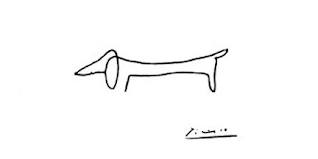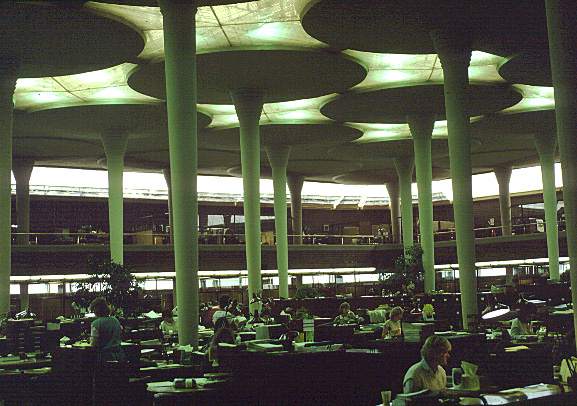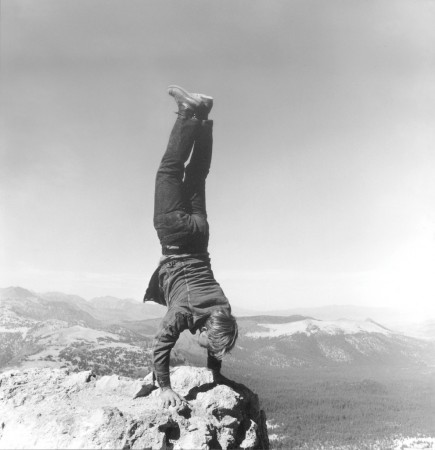Archive for the ‘Imagination’ Category
Beyond Dead Reckoning
 We’re afraid of technology development because it’s risky. And figuring out where to go is the risky part. To figure out where to go companies use several strategies: advance multiple technologies in parallel; ask the customer; or leave it to company leader’s edict. Each comes with its strengths and weaknesses.
We’re afraid of technology development because it’s risky. And figuring out where to go is the risky part. To figure out where to go companies use several strategies: advance multiple technologies in parallel; ask the customer; or leave it to company leader’s edict. Each comes with its strengths and weaknesses.
I think the best way to figure out where to go is to figure out where you are. And the best way to do that is data-driven S-curve analysis.
To collect data, look to your most recent product launches, say five, and characterize them using a goodness-to-cost ratio. (Think miles per gallon for your technology.) Then plot them chronologically and see how the goodness ratio has evolved – flat, slow growth, steep growth, or decline. The shape of the curve positions your technology within the stages of the S-curve and its location triangulated with contextual clues. You know where you are so you can figure out where to go.
Here’s what the stages feel like and what to do when you’re in them:
Stage 1: Infancy – New physics are used to deliver a known function, but it’s not ready for commercialization. This is like early days of the gasoline-electric hybrid vehicles, where the physics of internal combustion was combined with the physics of batteries. In Stage 1 the elements of the overall system are established, like when Honda developed its first generation Honda Insight and GM its EV1. Prototypes are under test, and they work okay, but not great. In Stage 1, goodness-to-cost is lower than existing technologies (and holding), but the bet is when they mature goodness-to-cost will be best on the planet.
If your previous products were Stage 4 (Maturity) or Stage 5 (Decline), your new project should be in Stage 1. If your existing project is in Stage 1, focus on commercialization. If all your previous projects were (are) in Stage 1, you should focus on commercializing one (moving to Stage 2) at the expense of starting a new one.
Stage 2: Transitional – A product is launched in the market and there is intense competition with existing technologies. In Stage 2, several versions of new technology are introduced (Prius, Prius pluggable, GM’s Volt, Nissan Leaf), and they fight it out. Goodness-to-cost is still less than existing technologies, but there’s some element of the technology that’s attractive. For electric vehicles, think emissions.
If your previous products were Stage 4 (Maturity) or Stage 5 (Decline) and your current project just transitioned from Stage 1, you’re in the right place. In Stage 2, fill gaps in functionality; increase controllability – better controls to improve battery performance; and develop support infrastructure -electric fueling stations.
Stage 3: Growth – Goodness-to-cost increases rapidly, and so do sales. (I think most important for an electric vehicle is miles per charge.)
If you’re in Stage 3, it’s time to find new applications – e.g., electric motorcycles, or shorten energy flow paths – small electric motors at the wheels.
Stage 4: Maturity – The product hits physical limits – flat miles per gallon; hits limits in resources – fossil fuels; hits economic limits – costly carbon fiber body panels to reduce weight; or there’s rapid growth in harmful factors – air pollution.
If you’re in Stage 4, in the short term add auxiliary functions – entertainment systems, mobile hotspot, heated steering wheel, heated washer fluid; or improve aesthetics – like the rise of the good looking small coupe. In the long term, start a Stage 1 project to move to new physics – hydrogen fuel cells.
Stage 5: Decline – New and more effective systems have entered their growth stage – Nissan Leaf outsells Ford pickup trucks.
If you’re in Stage 5, long ago you should have started at Stage 1 project – new physics. If you haven’t, it may be too late.
S-curve analysis guides, but doesn’t provide all the answers. That said, it’s far more powerful than rock-paper-scissors.
(This thinking was blatantly stolen from Victor Fey’s training on Advanced S-Curve Analysis. Thank you, Victor.)
The Pilgrimage of Change
 The pilgrimage of change is hard.
The pilgrimage of change is hard.
Before we start, we must believe there’s a way to get there.
Before that, we must believe in the goodness of the destination.
Before that, we must believe there’s a destination.
Before that, we must want something different.
Before that, we must see things as they are.
Before that, we must want to understand.
Before that, we must be curious.
And to do that, we must believe in ourselves.
The Archeologist Technologist
 Archeologists look back to see what was; they scratch the ground to find what the past left behind; then they study their bounty and speculate backward in time.
Archeologists look back to see what was; they scratch the ground to find what the past left behind; then they study their bounty and speculate backward in time.
But what makes a good archeologist? In a word – belief. Archeologists must believe there’s something out there, something under the dirt waiting for them. Sure, they use their smarts to choose the best place to dig and dig with the best tools, but they know something’s out there and have a burning desire to find it. The first rule of archeology – don’t dig, don’t find.
There’s almost direct overlap between archeologists and technologists, with one difference – where archeologists dig to define the past and technologists dig to define the future.
Technologists must use their knowledge and experience to dig in the right place and must use the best analytical digging tools. Creativity and knowledge are required to decide where to dig, and once unearthed the technologist must interpret the fragments and decide how to knit together the skeleton. But to me, the most important part of the analogy is belief – for the archeologist belief that fossils are buried under the dirt waiting to be discovered and for the technologist belief that technology is buried and waiting to be discovered.
Before powered flight, the Wright brothers believed technology was out there waiting for them. Their first flight was a monumental achievement, and I don’t want to devalue their work, but think about it – what did they create that wasn’t already there? Yes, they knit together technologies in new ways, but they didn’t create the laws of aerodynamics used for the wings (neither did the earliest aerodynamicists); they did not create the laws of thermodynamics behind the gasoline engine (neither did the early thermodynamicists who measured existing phenomena to make the laws); and they didn’t create the wood for the structure. But what they did do is dig for technology.
Space travel – for most of our history just a dream. But decades before rocket technology, it was all there waiting – the periodic table to make the fuel, the physics to make thrust, and the mechanics to create the structure. Natural resources and technologies were quilted together and processed in new ways, yes. But the technologies, or the rules to create them, were already there waiting to be discovered. And what Goddard did was dig.
The archeologist-technologist analogy can be helpful, but the notion of preexisting technology is way out there – it smacks of predestination in which I don’t believe.
But what I do believe in is belief – belief you have the capability to discover a forward-looking fossil – a future genus that others thought impossible. But only if you dig.
The first rule of technology – don’t dig, don’t find.
A Race To The Top
 We all want to increase sales. But to do do this, our products must offer a better value proposition – they must increase the goodness-to-cost ratio. And to do this we increase goodness and decrease cost. (No argument here – this is how everyone does it.) When new technologies mature, we design them in to increase goodness and change manufacturing and materials to reduce cost. Then, we sell. This is the proven cowpath. But there’s a problem.
We all want to increase sales. But to do do this, our products must offer a better value proposition – they must increase the goodness-to-cost ratio. And to do this we increase goodness and decrease cost. (No argument here – this is how everyone does it.) When new technologies mature, we design them in to increase goodness and change manufacturing and materials to reduce cost. Then, we sell. This is the proven cowpath. But there’s a problem.
The problem is everyone is thinking this way. You’re watching/developing the same technologies as your competitors; improving the same manufacturing processes; and trying the same materials. On its own, this a recipe for hyper-competition. But with the sinking economy driving more focus on fewer consumers, price is the differentiator. With this cowpath it’s a race to the bottom.
But there’s a better way where there are no competitors and millions (maybe billions) of untapped consumers clamoring for new products. Yes, it’s based on the time-tested method of improving the goodness-to-cost ratio, but there’s a twist – instead of more it’s less. The ratio is increased with less goodness and far less cost. Since no one in their right mind will take this less-with-far-less approach, there is no competition – it’s just you. And because you will provide less goodness, you must sell where others don’t – into the untapped sea of yet-to-be consumers of developing world. With less-with-far-less it’s a race to the top.
Technology is the most important element of less-with-far-less. By reducing some goodness requirements and dropping others all together, immature technologies become viable. You can incorporate fledgeling technologies sooner and commercialize products with their unreasonably large goodness-to-cost ratios. The trick – think less output and narrow-banded goodness.
Immature technologies have improved goodness-to-cost ratios (that’s why we like them), but their output is low. But when a product is designed to require less output, previously immature technologies become viable. Sure, there’s a little less goodness, but the cost structure is far less – just right for the developing world.
Immature technologies are more efficient and smaller, but their operating range is small. But when a product is designed to work within a narrow band of goodness, technologies become viable sooner. Yes, the product does less, but the cost structure is far less – a winning combination for the developing world.
Less-with-far-less makes the product fit the technology – that’s not the hard part. And less-with-far-less makes the product fit the developing world – not hard. In our all-you-can-eat world, where more is seen as the only way, we can’t comprehend how less can win the race to the top. The hard part is less.
Less-with-far-less is not limited by technology or market – it’s limited because we can’t see less as more.
Less-With-Far-Less for the Developing World
 The stalled world economy will make growth difficult, and companies are digging in for the long haul, getting ready to do more of what they do best – add more function and features, sell more into existing markets, and sell more to existing customers. More of the same, but better. But growth will not come easy with more-on-more thinking. It will be more-on-more trench warfare – ugly hand-to-hand combat with little ground gained. It’s time for another way. It’s time for less. It’s time to create new markets with less-with-far-less thinking.
The stalled world economy will make growth difficult, and companies are digging in for the long haul, getting ready to do more of what they do best – add more function and features, sell more into existing markets, and sell more to existing customers. More of the same, but better. But growth will not come easy with more-on-more thinking. It will be more-on-more trench warfare – ugly hand-to-hand combat with little ground gained. It’s time for another way. It’s time for less. It’s time to create new markets with less-with-far-less thinking.
Real growth will come from markets and consumers that don’t exist. Real (and big) growth will come from the developing world. They’re not buying now, but they will. They will when product are developed that fit them. But here’s the kicker – products for the developed world cannot be twisted and tweaked to fit. Your products must be re-imagined.
The fundamentals are different in the developing world. Three important ones are – ability to pay, population density, and literacy/skill.
The most important fundamental is the developing world’s ability to pay. They will buy, but to buy products must cost 10 to 100 times less. (No typo here – 10 to 100 times less.) Traditional cost reduction approaches such as Design for Manufacturing and Assembly (DFMA) won’t cut it – their 50% cost reductions are not even close. Reinvention is needed; radical innovation is needed; fundamental innovation is needed. Less-with-far-less thinking is needed.
To achieve 10-100X cost reductions, the product must do less and do it far more efficiency (with far less). Product functionality must be decimated – ripped off the bone until only bone remains. The product must do only one thing. Not two – one. The product must be stripped to its essence, and new technology must be developed to radically improve efficiency of delivering its essence. Products for the developing world will require higher levels of technology than products for the developed world.
Radical narrowing of functionality will make viable the smaller, immature, more efficient technologies. Infant technologies usually have lower output and less breadth, but that’s just what’s needed – narrow, deep, and less. Less-with-far-less.
In the developing world, population density is low. People are spread out, and rural is the norm. And it’s not developed world rural, it’s three-day-hike rural. In the developing world, people don’t go to products; products go to people. If it’s not portable, it won’t sell. And developing world portable does not mean wheels – it means backpack. Your products must fit in a backpack and must be light enough to carry in one.
Big, stationary, expensive equipment is not exempt. It also must fit in a backpack. And this cannot be achieved with twist-and-bend engineering. To fit in a backpack, the product must be stripped naked and new technology must be developed to radically improve efficiency. This requires radical narrowing, radical reimagining, and radical innovation. It requires less-with-far-less thinking. (And if it doesn’t run on batteries, it should at least have battery backup to deal with rolling blackouts.)
People in the developing world are intelligent, but most cannot read well and have little experience with developed world products. Where the developed world’s solution is picture-based installation instructions, less-with-far-less products for the developing world demand no instructions. For the developing world, the instruction manual is the on button. And this requires serious technology – software algorithms fed by low cost sensors. And the only way it’s possible is by distilling the product to its essence. Algorithms, yes, but algorithms to do only one thing very well. Less-with-far-less.
The developed world makes products with output that requires judgment – multi-colored graphical output that lets the user decide if things went well. Products for the developing world must have binary output – red/green, beep/no-beep. Less-with-far-less. But again, this seemingly lower-level functionality (a green light versus a digital display) actually requires more technology. The product must interpret results and decide if it’s good – much harder than a sexy graphical output that requires interpretation and judgement.
Creating products for the developing world requires different thinking. Instead of adding more functions and features, it’s about creating new technologies that do one thing very well (and nothing more) and do it with super efficiency. Products for the developing world require higher technologies than those for the developed world. And done well, the developed world will buy them. But the crazy thing is, the less-with-far-less products that will be a hit in the developing world will boomerang back and be an even bigger hit in the developed world.
You might be a superhero if…
- Using just dirt, rocks, and sticks, you can bring to life a product that makes life better for society.
- Using just your mind, you can radically simplify the factory by changing the product itself.
- Using your analytical skills, you can increase product function in ways that reinvent your industry.
- Using your knowledge of physics, you can solve a longstanding manufacturing problem by making a product insensitive to variation.
- Using your knowledge of Design for Manufacturing and Assembly, you can reduce product cost by 50%.
- Using your knowledge of materials, you can eliminate a fundamental factory bottleneck by changing what the product is made from.
- Using your curiosity and creativity, you can invent and commercialize a product that creates a new industry.
- Using your superpowers, you think you can fix a country’s economy one company at a time.
Celestial Work and Gravitational Pull
 Meeting agendas are a good idea. They make clear what will happen and they’re time bound. (At least good ones.) They look forward in time and shape what will happen.
Meeting agendas are a good idea. They make clear what will happen and they’re time bound. (At least good ones.) They look forward in time and shape what will happen.
Meeting agendas are created by the organizer so others follow. It’s strange to think about, but from thin air, the organizer congers magic words on a page that shape direction. The agenda sets the agenda and it’s followed. But in truth, agendas are followed because we choose to follow.
But I want to introduce another schema – the work sets the agenda. In this parallel universe, we don’t choose to follow an agenda; we choose to do work so powerful it sets the agenda – work so dense its gravitational field pulls the organization toward it.
I can hear the moans and groans – we can’t choose the work we do. But you can – if your work is good enough. If your work is brighter than the sun, it’s undeniable and, like the sun, cannot be ignored.
I can hear the next round of moans – we can’t do work that good. But you can – if you think you can and you try. (The only way to guarantee you can’t is not to try.)
And the last round of groans – we’ll get fired if we fail. If you’ll get fired for trying to reinvent your universe, you’re working at the wrong place anyway.
If you like to follow agendas, follow them. But if you don’t, do celestial work, and set them.
Creative Problem Creation
 Problems get a bad rap. We’re all clear on the negativity around problems, but we don’t appreciate their positive character. It’s time we use their powers for good.
Problems get a bad rap. We’re all clear on the negativity around problems, but we don’t appreciate their positive character. It’s time we use their powers for good.
One of the least popular characteristics of problems is their selfishness. Like the friend who shows up for dinner unannounced, problems, left to their own, care only about their calendar. But to overcome this shortcoming and harness their energy, we can create them to fit our time table.
An important strong suit of problems is their ability to create focus. When the VP has a problem, everybody has a problem. And it’s this persuasive power of problems that focuses the organization on a solution – resources, alignment, and creativity on demand.
I propose we bring problems to life on our own terms to create new thinking; to creatively fabricate problems to generate laser-focused thinking in the direction of our choice; to imagine what could be and create the right problems to get us there. Creativity on demand.
The most provocative and productive problems to manufacture are those that remove inherent goodness of your products or that outlaw their physical fundamentals. Like putting your thumb over a hose, these problems spray high velocity thinking in unpredictable directions. Here are some examples:
- Big coffee pot can make only one cup – single-cup brewer industry.
- Speedboats cannot carry multiple passengers – personal water craft industry.
- Lights must illuminate only a small area – LED proliferation.
- Sturdy running shoes must be floppy – bare foot running shoe movement.
- Desktop computers must be mobile – laptop industry.
- Stiff, wear-like-iron dungarees must be worn out – faded/distressed jean movement.
- Eye glasses cannot rest on the nose – contact lenses.
- Pencils cannot be sharpened – mechanical pencils.
- Laser printers must be slow – home printer industry.
Sure, these examples were reverse engineered. But take a minute to walk back in time and sit in those industries. What if back then you created those problems for yourself? What if you create them tomorrow?
The thinking in the post is strongly shaped by Jeffrey Paul Baumgartner’s Anti Conventional Thinking (ACT).
Curiosity Fuels Creativity
 Creativity generates things that are novel and useful. Make them successful, and you’ve got innovation. There can be no innovation without creativity.
Creativity generates things that are novel and useful. Make them successful, and you’ve got innovation. There can be no innovation without creativity.
We associate creativity with innate ability that only some have; with transparent happenings that can’t be codified; with eureka moments that come from the subconscious. If anything defies process, it’s creativity. So let’s not use process to squelch creativity, let’s foster behaviors that spawn creativity.
Curiosity is the kindling for creativity; fan its flames and creativity ignites. There a two parts to curiosity – to see things as they are and to propose what could be.
To see things as they are is to create awareness of what is – awareness of context, or changes in context, awareness of worn paths and anomalies, and awareness at high and low levels of abstraction. It takes a disciplined, uncluttered mind to become aware of a new reality, especially while sitting in the old one. And because uncluttering comes only from slack time, to see things as they are is doubly difficult.
The next part of curiosity is to challenge what is in order to propose what could be. To start, root cause must be understood for the new what is. This requires active rejection of old fundamentals and a deep dive to understand new ones. This is toughest when the old fundamentals have been (and are still) successful. (And it’s doubly tough because it requires slack time.) Curiosity twists, pounds, and bends the new fundamentals into a future reality which culminates with a proposal of what could be. Done right, curiosity’s proposal is borderline heretical.
The good news is we don’t need new people – we have plenty of creative capacity. But here’s the bad news – our process thinking isn’t going to get us there because it’s all about behaviors. It’s time to think about how to change things so we can spend more time on behaviors that generate creativity. But if you must use process thinking, come up with a process that lets us spend more time on creative behaviors
The thinking (and some of the language) for this post came from Diego Uribe, a true thought leader in creativity. Thank you Diego.
Mindset for Doing New
 The more work I do with innovation, the more I believe mindset is the most important thing. Here’s what I believe:
The more work I do with innovation, the more I believe mindset is the most important thing. Here’s what I believe:
Doing new doesn’t take a lot of time; it’s getting your mind ready that takes time.
Engineers must get over their fear of doing new.
Without a problem there can be no newness.
Problem definition is the most important part of problem solving.
If you believe it can work or it can’t, you’re right.
Activity is different from progress.
Thinking is progress.
In short, I believe state-of-the-art is limited by state-of-mind.
The Dark Art of Uncertainty
 Engineers hate uncertainty. (More precisely, it scares us to death.) And our role in the company is to snuff it out at every turn, or so we think.
Engineers hate uncertainty. (More precisely, it scares us to death.) And our role in the company is to snuff it out at every turn, or so we think.
To shield ourselves from uncertainty, we take refuge in our analyses. We create intricate computer wizardry to calm our soles. We tell ourselves our analytic powers can stand toe-to-toe with uncertainty. Though too afraid to admit, at the deepest level we know the magic of our analytics can’t dispatch uncertainty. Like He-Who-Should-Not-Should-Be-Named, uncertainty is ever-present and all-powerful. And he last thing we want is to call it by name.
Our best feint is to kill uncertainty before it festers. As soon as uncertainty is birthed, we try slay it with our guttural chant “It won’t work, it won’t work, it won’t work”. Like Dementors, we drain peace, hope, and happiness out of the air around a new idea. We suck out every good feeling and reduce it to something like itself, but soulless. We feed on it until we’re left with nothing but the worst of the idea.1
Insidiously, we conjure premonitions of mythical problems and predict off-axis maladies. And then we cast hexes on innovators when they don’t have answers to our irrelevant quandaries.
But our unnatural bias against uncertainty is misplaced. Without uncertainty there is no learning. Luckily, there are contrivances to battle the dark art of uncertainty.
When the engineering warlocks start their magic, ask them to be specific about their premonitions. Demand they define the problem narrowly – between two elements of the best embodiment; demand they describe the physical mechanisms behind the problem (warlocks are no match for physics); demand they define the problem narrowly in time – when the system spools up, when it slows down, just before it gets hot, right after it cools down. What the warlocks quickly learn is the problem is not the uncertainty around the new idea; the problem is the uncertainty of their knowledge. After several clashes with the talisman of physics, they take off their funny pointy hats, put away their wands, and start contributing in a constructive way. They’re now in the right frame of mind to obsolete their best work
Uncertainty is not bad. Denying it exists is bad, and pretending we can eliminate it is bad. It’s time to demonstrate Potter-like behavior and name what others dare not name.
Uncertainty, Uncertainty, Uncertainty.

 Mike Shipulski
Mike Shipulski